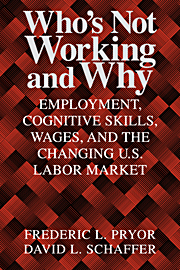9 - Final Observations
Published online by Cambridge University Press: 25 March 2010
Summary
In the previous eight chapters we present our explanation for the major trends in the U.S. labor market over the last quarter-century. In particular, we focus on explaining four critical and interrelated trends in employment and wages. Along the way, we cover considerable territory and, therefore, it is useful to provide a perspective by briefly restating our entire argument. We must then try to answer several broad and important questions: Will joblessness, particularly among prime-age males, continue to rise? Will other labor market trends of the past quarter-century continue into the future? And what measures are available to the government to ameliorate some of the adverse effects of the trends we document?
A Summary of the Analysis
The framework for our labor market analysis is a model of four distinct labor markets defined by occupation. The tier 4 labor market consists of the market for all the jobs in occupations with the highest levels of education intensity. The tier 1 labor market consists of the market for all the jobs in occupations with the lowest levels of education intensity. The tier 3 and tier 2 labor markets fall in between.
Within each labor market, we assume that supply and demand determine employment and wages, subject to a considerable degree of wage stickiness. This wage stickiness is generated by various “efficiency wage” type situations in which individual firms decide that the advantages of lowering wages (for instance, lower salary costs) are outweighed by the disadvantages (for instance, lower morale, higher turnover, more shirking).
In this type of framework, excess supply in the tier 4 labor market is not quickly eliminated by falling wages.
- Type
- Chapter
- Information
- Who's Not Working and WhyEmployment, Cognitive Skills, Wages, and the Changing U.S. Labor Market, pp. 216 - 233Publisher: Cambridge University PressPrint publication year: 1999



